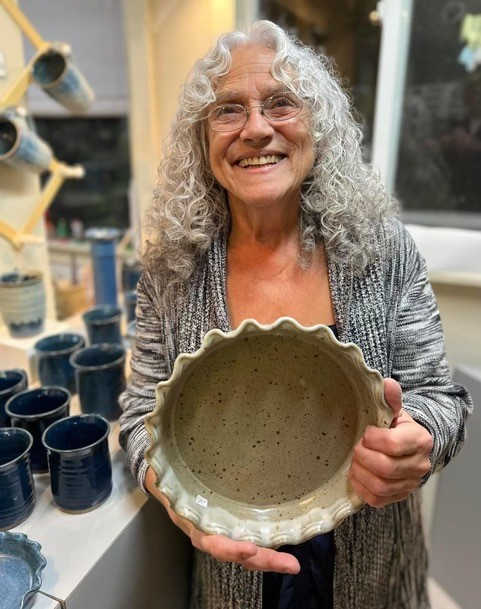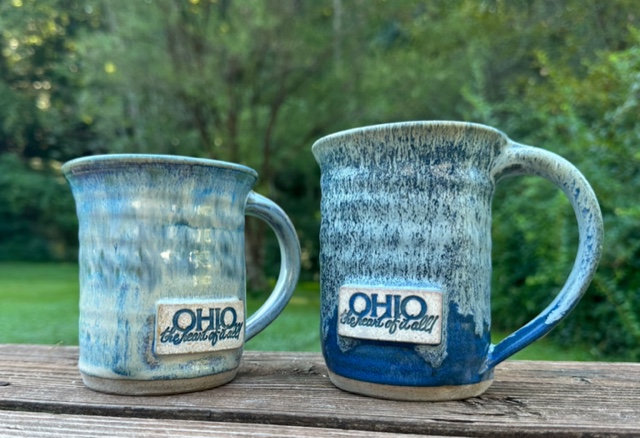Susan Abramovitz Named 2024 Ohio Heritage Fellowship Recipient by Ohio Arts Council
FOR IMMEDIATE RELEASE
Tuesday, November 12, 2024

Athens, OH – The Ohio Arts Council (OAC), a state agency that supports the arts in Ohio, is proud to announce Susan Abramovitz as a 2024 Ohio Heritage Fellow. The Ohio Heritage Fellowship program recognizes the state's best folk and traditional artists, celebrating their lifelong dedication to preserving and perpetuating Ohio's rich cultural heritage.
 Established in 2003, the Ohio Heritage Fellowship program honors individuals whose artistic achievements have significantly impacted Ohio's cultural landscape. Past recipients include organizations like the Cleveland Hungarian Heritage Society (2006) and esteemed artists like Paul ‘Moon’ Mullins (2007) and Hasu Patel (2018).
Established in 2003, the Ohio Heritage Fellowship program honors individuals whose artistic achievements have significantly impacted Ohio's cultural landscape. Past recipients include organizations like the Cleveland Hungarian Heritage Society (2006) and esteemed artists like Paul ‘Moon’ Mullins (2007) and Hasu Patel (2018). Susan Abramovitz is a distinguished functional potter who has dedicated nearly five decades to her craft. Renowned for her unique style, Abramovitz has been a leading figure in southeastern Ohio's pottery scene for over 48 years. Her beautiful, functional pieces are prized by collectors worldwide, who appreciate the artistry and practicality of her work.
“Susan Abramovitz is a true master of her craft,” said the Ohio Arts Council. “Her dedication to traditional pottery techniques and her commitment to sharing her knowledge with others perfectly embodies the spirit of the Ohio Heritage Fellowship program. We are honored to recognize her remarkable contributions to Ohio's artistic heritage.”
Each Ohio Heritage Fellow receives a $5,000 award in recognition of their artistic excellence.
To learn more about the Ohio Arts Council and the Ohio Heritage Fellowship program, please visit:
Ohio Arts Council website: https://oac.ohio.gov/
2024 Ohio Heritage Fellows announcement: https://oac.ohio.gov/grants/01-guidelines
To learn more about Susan Abramovitz's work, please visit:
Rock Riffle Run Pottery website: https://www.rockrifflerunpottery.com/about-us
Video of Award Presentation: https://youtu.be/8LZ2W_KiS8M
###
Contacts:
* Cristina Benedetti, Folk & Traditional Arts Contractor, Ohio Arts Council, cristina.benedetti@oac.ohio.gov
* Chaz O’Neil, Artists Programs / Percent for Art Coordinator / Ohio Arts Council, 614 728 4421 / Chaz.oneil@oac.ohio.gov
* Kathy Signorino, Individual Artist / Percent for Art Director / Ohio Arts Council, 614 728 6140 / Kathy.signorino@oac.ohio.gov
* Susan Abramovitz, rockrifl@gmail.com, 740-517-8523
-------------------------------------------------------------------
Susan Abramovitz 2024 Award Winner
OAC's Story on Susan Below (duplicated from https://oac.ohio.gov/)
Susan Abramovitz has spent the last 48 years in the production and marketing of traditional, functional pottery, and has made a living from her craft. She is considered one of the best in her style of pottery in Southeastern Ohio, and shares her work with avid collectors from all over the world who use her functional pottery daily. Abramovitz established her business in 1978, after leaving her position as the head of the ceramics department at Case Western Reserve University in Cleveland. All along, she has been supportive of fledgling potters, showing them techniques that would help them to navigate their own paths.
Susan uses a stoneware clay body that she developed herself, using raw materials mixed in her studio from ingredients found in the nearby landscape. She has also offered her expertise and knowledge of clay to preserve a stoneware clay called Goldart from extinction. By 1984 Goldart quality had greatly declined due to high sulfur and iron contamination, threatening its removal from the market. Working with ceramic engineer Steven Blankenbeker from Cedar Heights Clay Company in Oak Hill, Ohio, Susan helped to save this staple of stoneware pottery by her painstaking testing and historic knowledge of pottery techniques.
What is appealing to you about making functional art like pottery?
It seemed to have a purpose, and I've always been inclined towards things that have a purpose. Not that sculpture doesn’t, because it does, but these are things that people can live with every day. And I kind of like that. My brain is the kind that form follows function. And, it’s a lot to think about, because more goes into that casserole than you would ever imagine! So, these are like normal, everyday problems that I've gotten the opportunity to work on.
And another totally cool thing—and I think about this every time I do it—is people in my profession have been making cremation jars since people were being buried and clay first got knocked into the fire and got hard. So, I'm part of this tradition that's really thousands of years old. I don't make cremation jars that often, but because I am a potter, I do get asked to do that. And it’s a very sacred thing, because it’s so special and, and it’s a really neat tradition to be part of.
 What roles do tradition and innovation play in your work?
What roles do tradition and innovation play in your work? The tradition of pottery is thousands of years old, so truly, I'm using the same method of making those materials work that were used 3,000 years ago—but I have gas burners that I can turn on. I have electricity that runs my potter's wheel, but essentially it hasn't changed that much. Fire is what makes it permanent. And my clay that I use right now is 350 million years old. That is amazing. The clay that the Native Americans used here, that they dug out of the creek, it was the same seam that was 350 million years old. So that’s kind of an amazing thing to be dealing with, that kind of a material, and the fact that fire is what's making it permanent. It doesn't matter where the fire comes from, but it needs the fire. It used to be wood, and it still is in a lot of cases, but my kiln is fired with propane gas.
This field never gets boring. Frustrating, sometimes, but I've been doing this for 50 years practically every day, and I feel like I’m just at the tip of the iceberg. It's not a boring job! It can be hard, though.
Susan works with another woman at a pottery wheel in the studio.What is special about being a potter in Southeast Ohio, and what brought you to the area?
The natural resources, and the fact that I was born in Ohio. After college, I lived and worked in Maine for a potter. And when I lived in New England, I realized, if your family hasn't been there for 350 years, you're an out-of-stater.
And I thought, “You know what? I was born in Ohio. I'm going back to Ohio.” And I decided I needed to go to the prettiest part of Ohio, because the visual is a big part of my life. I grew up in Youngstown, I worked and I went to school in Cleveland, and I wanted to be more centered in nature. I also didn’t want to pay an absolute fortune to have my material shipped in, because clay is really heavy, and when you order something, you don't order a little—you order a ton or two tons or three tons. So, it just made a lot of sense, because our tradition of pottery is really long and, so it’s kind of a natural thing for Ohioans.
Information


